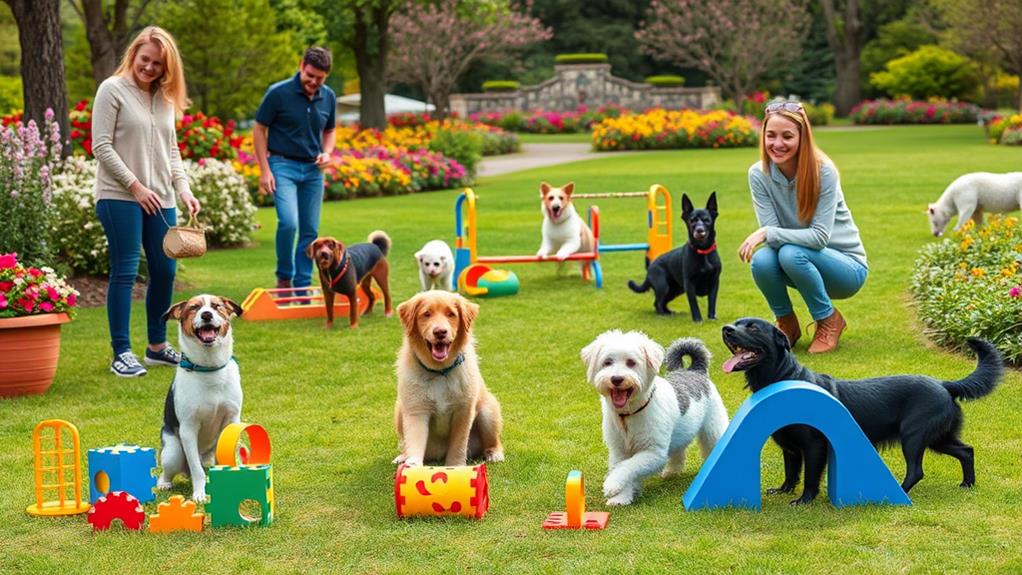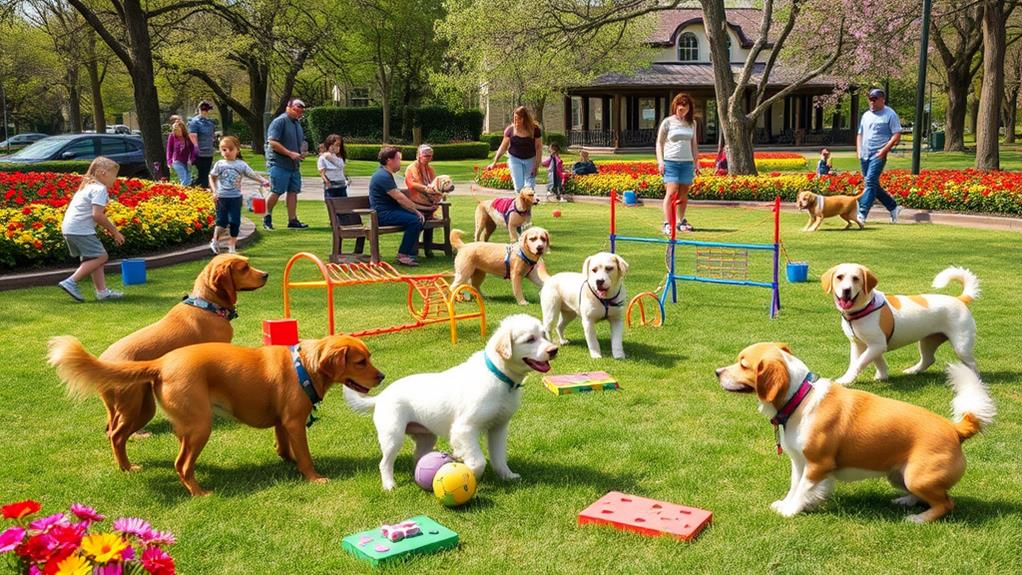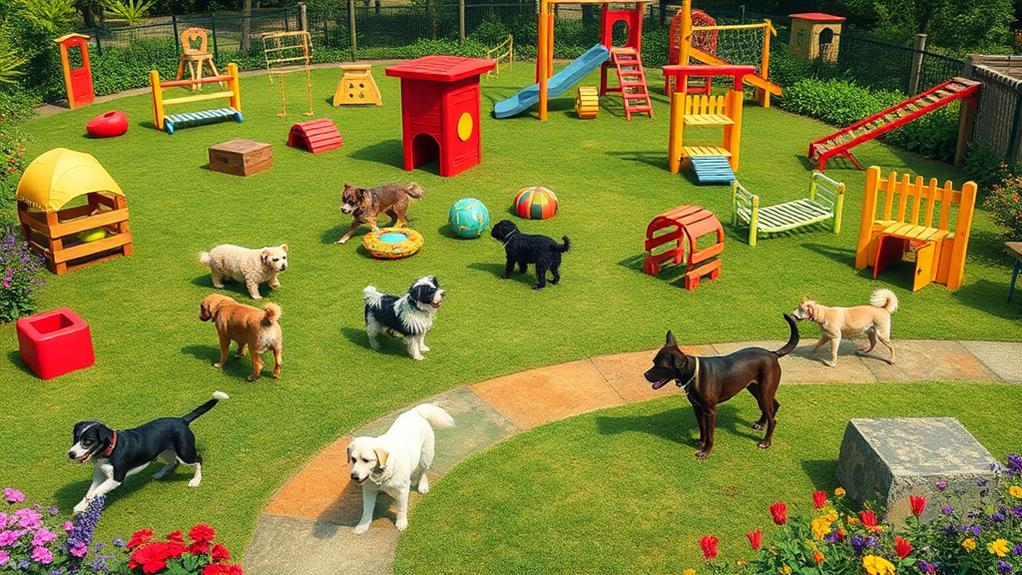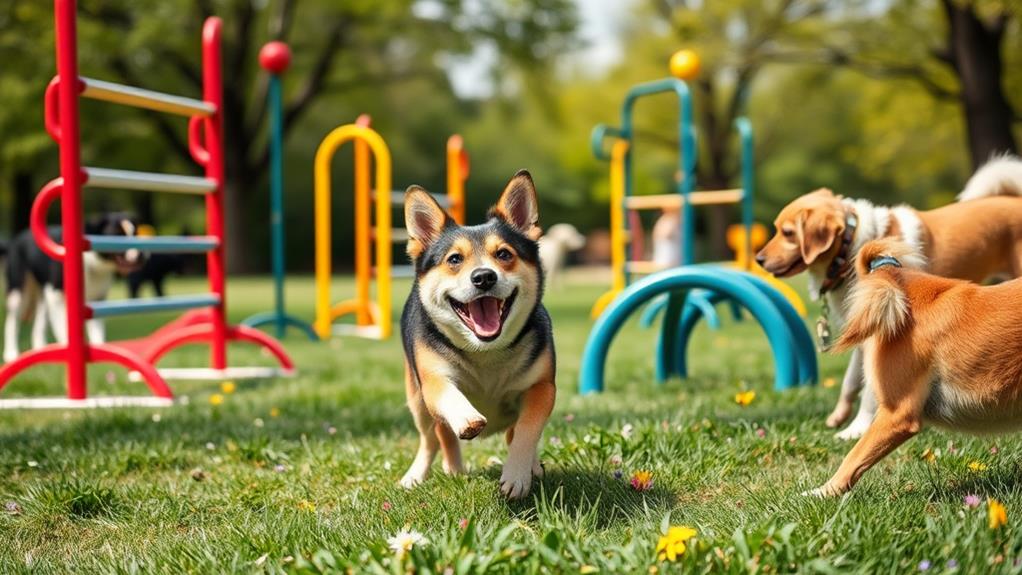Mentally stimulating environments are key to your dog's wellness because they reduce boredom and destructive behaviors. When you engage your dog with problem-solving activities, like interactive toys or agility courses, you boost their cognitive abilities. This stimulation enhances focus during training and strengthens your bond. Plus, varied experiences—like new walking routes—help alleviate anxiety by providing an outlet for energy and curiosity. A well-stimulated dog often shows playful behavior, increased engagement, and improved responsiveness. Discovering more ways to enrich your dog's life can make a significant difference in their happiness and health.
Understanding Canine Intelligence

While many people think of intelligence with respect to human-like reasoning, understanding canine intelligence necessitates a more extensive outlook. Dogs exhibit their smarts through various forms, from problem-solving abilities to emotional intelligence. You might notice how your dog learns commands quickly or figures out puzzle toys. This adaptability highlights their capacity to learn through experiences and observations.
Canine intelligence also involves social skills. Dogs can read human emotions and respond accordingly, which reflects their keen ability to bond with you and others. They pick up on cues like tone of voice, body language, and even facial expressions. This social intelligence is important for their interaction within a family environment or with other dogs.
Moreover, different breeds exhibit varying levels of intelligence, influenced by their history and purpose. For instance, working breeds often showcase high problem-solving skills, while companion breeds may excel in social interactions.
Understanding these facets of canine intelligence allows you to appreciate your dog's unique abilities and strengths. By recognizing their intelligence, you can create a more engaging and fulfilling environment that caters to their mental and emotional needs.
Benefits of Mental Stimulation

Mental stimulation is critical for your dog's overall well-being. Engaging your pup's mind not only keeps them entertained but also contributes to their emotional and physical health.
When you provide mental challenges, your dog enjoys numerous benefits, including:
- Reduced boredom: Keeps your dog from destructive behaviors.
- Improved focus: Enhances their ability to concentrate during training.
- Enhanced problem-solving skills: Boosts their cognitive abilities and adaptability.
- Strengthened bond: Encourages quality time between you and your dog.
- Stress relief: Helps mitigate anxiety by providing a constructive outlet for energy.
Creative Play Ideas

Engaging your dog in creative play not only builds on the benefits of mental stimulation but also adds fun and excitement to their routine. You can start by introducing interactive toys that require your dog to solve puzzles for treats. This not only keeps their brain active but also rewards them for their efforts.
Another idea is to set up an obstacle course using household items. Use chairs, cushions, and boxes to create challenges for your dog to navigate. This encourages physical activity while stimulating their minds as they figure out how to overcome each obstacle.
Hide and seek is a classic game that dogs love. Have your dog stay while you hide, then call them to find you. This not only strengthens your bond but also sharpens their problem-solving skills.
Lastly, consider teaching your dog new tricks. Whether it's rolling over, playing dead, or dancing, each new command challenges their cognitive abilities and keeps them engaged.
Environmental Enrichment Techniques

To enhance your dog's quality of life, implementing environmental enrichment techniques is essential. These techniques stimulate your dog's mind and body, making them happier and healthier.
Interactive toys: Use puzzle toys that challenge your dog to think critically and engage in problem-solving.
Scent games: Hide treats around your home or yard, encouraging your dog to use their nose and explore their environment.
Agility courses: Set up a mini agility course with tunnels, jumps, and weave poles to promote physical activity and mental stimulation.
Socialization opportunities: Arrange playdates with other dogs or visit dog parks to enhance their social skills and provide new experiences.
Varied walking routes: Change your walking routine regularly to expose your dog to different sights, sounds, and smells.
Signs of a Stimulated Dog

A happy dog often shows signs of mental and physical stimulation. You'll notice your pup's energy levels are high, and they're eager to engage with you and their environment. When dogs are mentally stimulated, they exhibit playful behavior, such as bouncing around or playfully nudging you for attention.
Look for signs of curiosity; if your dog explores new sights and smells during walks or while at home, they're likely mentally engaged. A stimulated dog may also display increased focus during training sessions, responding quickly to commands or cues.
Another indicator is their ability to settle down after playtime. If your dog can relax and rest, it shows they've had enough stimulation. Additionally, you might see changes in their body language; an alert posture with ears perked up indicates excitement and engagement.
Lastly, pay attention to their social interactions. A dog that enjoys playing with other dogs or people is often mentally stimulated. If you observe these signs in your dog, it's a clear indication that they're thriving in a mentally enriching environment.
Frequently Asked Questions
Can Mental Stimulation Help With My Dog's Behavioral Issues?
Yes, mental stimulation can greatly help with your dog's behavioral issues. Engaging activities keep their minds active, reducing boredom and anxiety. You'll notice improved focus, better obedience, and a happier, more balanced pup.
How Often Should I Provide Mental Stimulation for My Dog?
You should provide mental stimulation for your dog daily. Aim for at least 30 minutes of interactive play, puzzles, or training exercises. Keeping it consistent helps maintain your dog's interest and overall well-being.
Are There Specific Breeds That Require More Mental Stimulation?
Think of your dog as a bright flame; some breeds burn hotter. High-energy dogs like Border Collies or Belgian Malinois thrive on mental challenges, while others might prefer a more relaxed pace. Tailor stimulation to their needs.
Can Too Much Stimulation Be Harmful to My Dog?
Yes, too much stimulation can overwhelm your dog, leading to stress and anxiety. It is critical to balance mental activities with downtime, ensuring your dog feels secure and relaxed while enjoying their environment.
How Can I Tell if My Dog Is Bored or Overstimulated?
To tell if your dog's bored or overstimulated, watch their behavior. Signs of boredom include chewing or excessive barking, while overstimulation might show through panting, pacing, or trying to hide. Adjust activities accordingly to maintain balance.
Conclusion
So, you've learned about the power of mental stimulation for your furry friend. Imagine the joy of watching your dog thrive, their tail wagging with excitement as they tackle a new challenge. But what if you could reveal even more potential in them? With creative play and enriching environments, you can transform their daily routine into an adventure. Don't wait—start exploring these techniques today, and see how your dog's wellness and happiness can soar to new heights!



